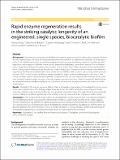Files in this item
Rapid enzyme regeneration results in the striking catalytic longevity of an engineered, single species, biocatalytic biofilm
Item metadata
| dc.contributor.author | Tong, Xiaoxue | |
| dc.contributor.author | Barberi, Tania Triscari | |
| dc.contributor.author | Botting, Catherine H. | |
| dc.contributor.author | Sharma, Sunil V. | |
| dc.contributor.author | Simmons, Mark J. H. | |
| dc.contributor.author | Overton, Tim W. | |
| dc.contributor.author | Goss, Rebecca J. M. | |
| dc.date.accessioned | 2016-10-24T13:30:15Z | |
| dc.date.available | 2016-10-24T13:30:15Z | |
| dc.date.issued | 2016-10-21 | |
| dc.identifier | 247036803 | |
| dc.identifier | 24d4f362-1760-4fb6-b2e3-f6704d05a83c | |
| dc.identifier | 84992096639 | |
| dc.identifier | 000385728400003 | |
| dc.identifier.citation | Tong , X , Barberi , T T , Botting , C H , Sharma , S V , Simmons , M J H , Overton , T W & Goss , R J M 2016 , ' Rapid enzyme regeneration results in the striking catalytic longevity of an engineered, single species, biocatalytic biofilm ' , Microbial Cell Factories , vol. 15 , no. 1 , 180 . https://doi.org/10.1186/s12934-016-0579-3 | en |
| dc.identifier.issn | 1475-2859 | |
| dc.identifier.other | RIS: Tong2016 | |
| dc.identifier.uri | https://hdl.handle.net/10023/9692 | |
| dc.description | This work was supported by BBSRC Grant BB/I008713/2 and European Research Council under the European Union’s Seventh Framework Programme (FP7/2007–2013/ERC Grant agreement no 614779) to Goss and BB/I006834/1 to Simmons. | en |
| dc.description.abstract | Background: Engineering of single-species biofilms for enzymatic generation of fine chemicals is attractive. We have recently demonstrated the utility of an engineered Escherichia coli biofilm as a platform for synthesis of 5-halotryptophan. E. coli PHL644, expressing a recombinant tryptophan synthase, was employed to generate a biofilm. Its rapid deposition, and instigation of biofilm formation, was enforced by employing a spin-down method. The biofilm presents a large three-dimensional surface area, excellent for biocatalysis. The catalytic longevity of the engineered biofilm is striking, and we had postulated that this was likely to largely result from protection conferred to recombinant enzymes by biofilm’s extracellular matrix. SILAC (stable isotopic labelled amino acids in cell cultures), and in particular dynamic SILAC, in which pulses of different isotopically labelled amino acids are administered to cells over a time course, has been used to follow the fate of proteins. To explore within our spin coated biofilm, whether the recombinant enzyme’s longevity might be in part due to its regeneration, we introduced pulses of isotopically labelled lysine and phenylalanine into medium overlaying the biofilm and followed their incorporation over the course of biofilm development. Results: Through SILAC analysis, we reveal that constant and complete regeneration of recombinant enzymes occurs within spin coated biofilms. The striking catalytic longevity within the biofilm results from more than just simple protection of active enzyme by the biofilm and its associated extracellular matrix. The replenishment of recombinant enzyme is likely to contribute significantly to the catalytic longevity observed for the engineered biofilm system. Conclusions: Here we provide the first evidence of a recombinant enzyme’s regeneration in an engineered biofilm. The recombinant enzyme was constantly replenished over time as evidenced by dynamic SILAC, which suggests that the engineered E. coli biofilms are highly metabolically active, having a not inconsiderable energetic demand. The constant renewal of recombinant enzyme highlights the attractive possibility of utilising this biofilm system as a dynamic platform into which enzymes of interest can be introduced in a “plug-and-play” fashion and potentially be controlled through promoter switching for production of a series of desired fine chemicals. | |
| dc.format.extent | 11 | |
| dc.format.extent | 1674828 | |
| dc.language.iso | eng | |
| dc.relation.ispartof | Microbial Cell Factories | en |
| dc.subject | Engineered E, coli biofilm | en |
| dc.subject | Biotransformation | en |
| dc.subject | Biocatalysis | en |
| dc.subject | Tryptophan synthase | en |
| dc.subject | Halotryptophan | en |
| dc.subject | QD Chemistry | en |
| dc.subject | NDAS | en |
| dc.subject.lcc | QD | en |
| dc.title | Rapid enzyme regeneration results in the striking catalytic longevity of an engineered, single species, biocatalytic biofilm | en |
| dc.type | Journal article | en |
| dc.contributor.sponsor | BBSRC | en |
| dc.contributor.sponsor | European Research Council | en |
| dc.contributor.institution | University of St Andrews. School of Chemistry | en |
| dc.contributor.institution | University of St Andrews. Biomedical Sciences Research Complex | en |
| dc.contributor.institution | University of St Andrews. EaSTCHEM | en |
| dc.identifier.doi | https://doi.org/10.1186/s12934-016-0579-3 | |
| dc.description.status | Peer reviewed | en |
| dc.identifier.grantnumber | BB/I008713/2 | en |
| dc.identifier.grantnumber | GCGXC | en |
This item appears in the following Collection(s)
Items in the St Andrews Research Repository are protected by copyright, with all rights reserved, unless otherwise indicated.

